Art & Exhibitions
Pinault vs. Arnault: Dueling Art Shows Foreshadow the Battle That Will Reshape the Paris Museum Scene
François Pinault and Bernard Arnault mark their territories with revealing group shows in Venice and Paris.
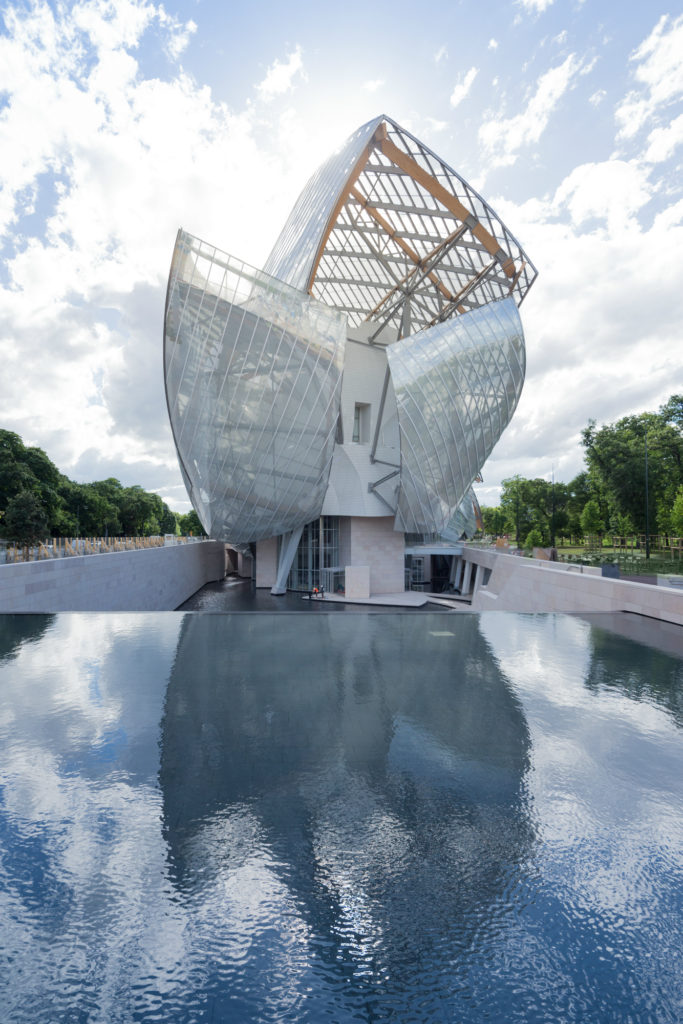
François Pinault and Bernard Arnault mark their territories with revealing group shows in Venice and Paris.

Hettie Judah

It’s a new season—in the exhibition cycle, as in the fashion world—and the new group shows at the Pinault Collection in Venice and Fondation Louis Vuitton in Paris are both appropriately modish in their concerns.
One might view the latest exhibitions at the French luxury goods billionaires’s spaces as the calm before a storm. Next year, François Pinault is due to open a long-planned Paris site for his collection. His Tadao Ando-designed space will occupy the old building of the Paris Bourse. Bernard Arnault unveiled his Frank Gehry-designed museum in 2014. Shows of masterworks from Russian museums and New York’s MoMA have quickly made it a formidable player.
As the two enterprises—each based around the collection of competitive businessmen—currently ranked number four (Arnault) and number 30 (Pinault) on Forbes’s list of the world’s billionaires—prepare to share territory, the pressure is on to make the one distinct from the other. Less, perhaps, as a fight for audience share, and more as a way of arguing for their own significance.
“In Tune With the World,” the headline show at the Fondation Louis Vuitton, is a multimedia edit from the collection exploring mankind’s relationship to the world in a broad-brush flirtation with object-oriented ontology. In a display of unshown (here, at least) works, there is much that feels familiar: hits from the international scene as well as echoes from what we already know of the collection.
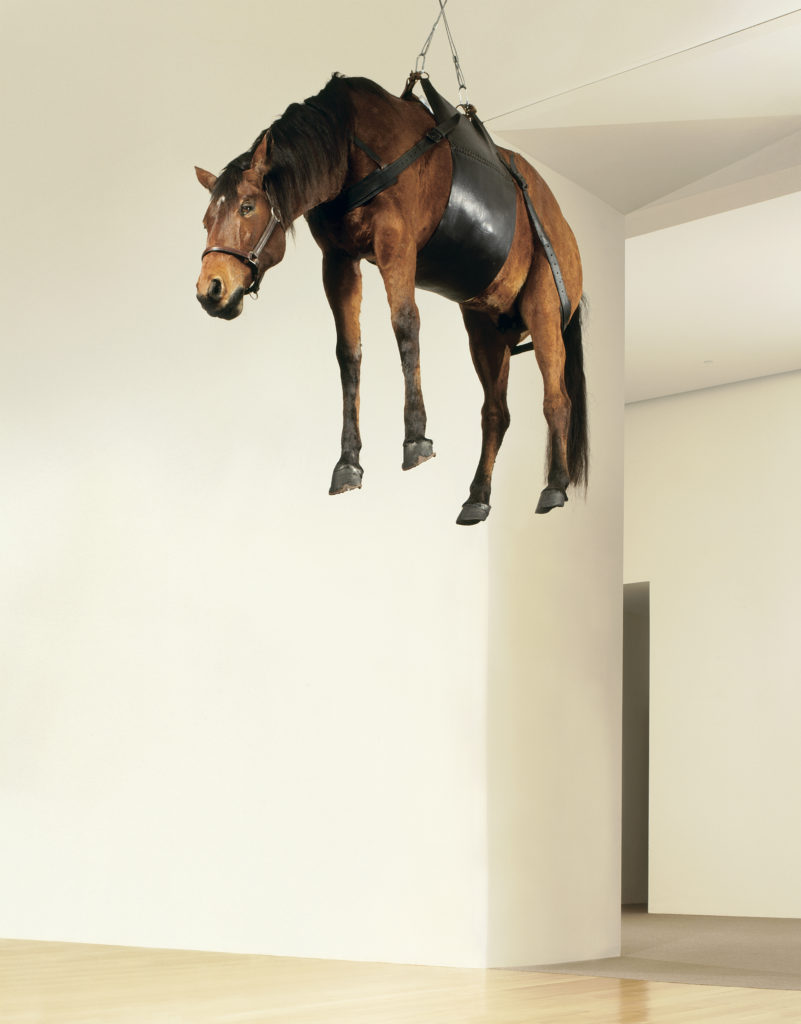
Maurizio Cattelan, The ballata di Trotski (1996), copyright the artist.
Among the moderns: A handful of prime Giacometti bronzes; Matisse’s Blue Nude with Green Stockings; a clutch of Kleins. There are also contemporary heavyweights: Gerhard Richters; Philippe Parreno’s cuttlefish movie Anywhen (2017); Pierre Huyghe’s monkey flick Untitled (Human Mask) (2014); and Maurizio Cattelan’s well-known La balata di Trotski (1996)—a horse, trotting no more, suspended from the ceiling in a leather sling.
There are hints of the collection branching out in new directions. Highlights include Annicka Yi’s 3D video The Flavor Genome (2016)—a fictional documentary following a perfume hunter down the Amazon river in search of a mysterious hybrid scent—and Trisha Donnelly’s lyrical, if disorienting, video of scudding clouds morphing into abstract forms (Untitled, 2014). Here, too: works by Mark Bradford, Shimabuku, Andrea Crespo and Bunny Rogers.
Somewhat incongruous—though not entirely so—is a top floor dedicated to Takashi Murakami in apocalyptic mode. Works such as the 23-foot wide a.k.a Gero Tan: Noah’s Ark (2016) blast entropy and nausea: the artist’s familiar cartoonish figures rot, puke, and melt, their comic book palette whirled together into a khaki slurry like smushed Plasticine.
In Venice’s Punta della Dogana, the Pinault Collection presents “Dancing With Myself,” exploring the construction of self, and artists’ use of their own bodies. Less an examination of self portraiture than an examination of the human body as a raw material for art, the exhibition is an interestingly self-regarding counterposition to the environmental concerns broadcast by “In Tune With the World”.
It opens with spectacle: Felix Gonzalez-Torres’s Untitled (Blood) bead curtain from 1992, installed at vast scale; Urs Fischer’s self portrait as a melting candle, and Alighiero Boetti’s hot-headed metal statue hosing water onto its steaming pate.
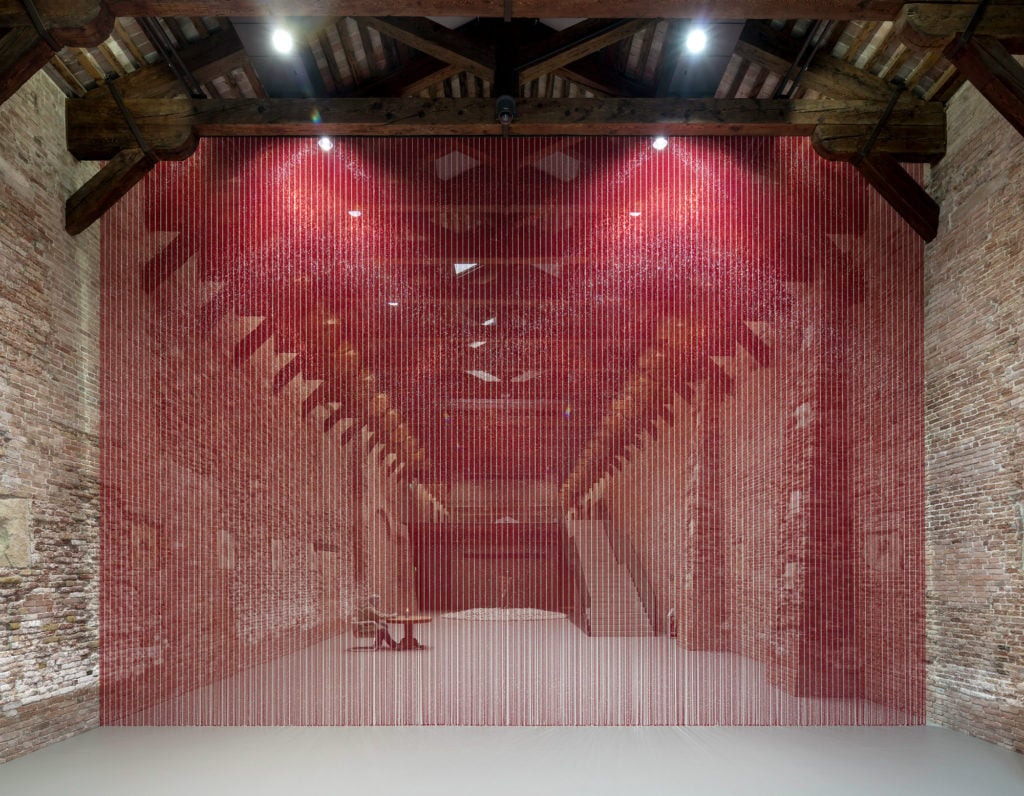
Felix Gonzalez-Torres, Untitled (Blood) (1992) in “Dancing With Myself.” Copyright Palazzo Grassi, photography by Matteo De Fina.
The headliners include Cindy Sherman’s art school movie (Doll Clothes, 1975) and works by Robert Gober, Charles Ray, Maurizio Cattelan (again), and Gilbert & George. There were some exciting arrivals within the collection, notably galleries of recent work by both Paulo Nazareth and LaToya Ruby Frazier, as well as a series of self-portraits by outsider artist Marcel Bascoulard.
The entirety of the Pinault Collection’s other Venetian venue, the Palazzo Grassi, is dedicated to the German painter Albert Oehlen. Nothing against Oehlen, his work, or the show itself, but as the latest in an unbroken line of monographic displays of works by white Euro-American men (Urs Fischer, Rudolf Stingel, Irving Penn, Martial Raysse, Sigmar Polke, Damien Hirst…), it felt unadventurous as a choice of exhibition.
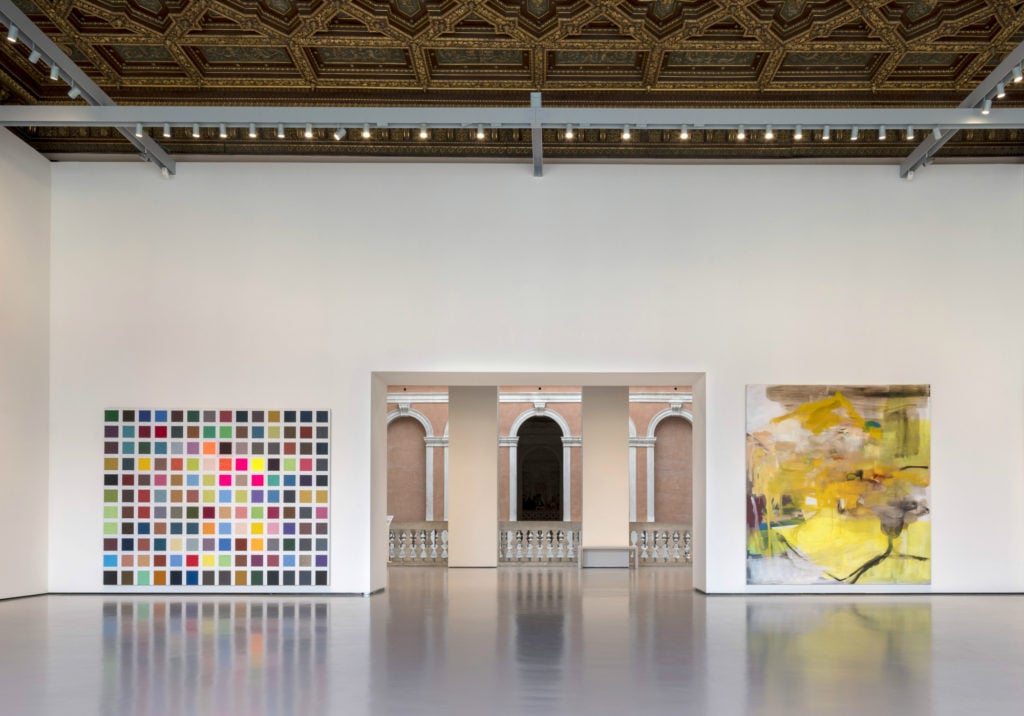
“Albert Oehlen: Cows by the Water,” installation view at Palazzo Grassi, 2018, copyright, Palazzo Grassi, photography by Matteo De Fina.
“Of course it’s clear that this has to change,” agreed Martin Bethenod, the director and CEO of the Pinault Collection when asked about its unbroken run of “men only” solo shows. Were there female artists in the collection that they were considering for monographic exhibitions in the future? “Of course, yes,” he said, though he was too discreet to share names.
At his own suggestion, Bethenod will assume responsibility for both the Paris and Venice sites “to ensure, first, that the rise of Paris won’t be the decline of Venice, and second that there wouldn’t be competition between the two spaces.” Programming will continue in the established vein: a mixture of thematic group shows and monographic exhibitions, all seen through the prism of the Collection. Where appropriate, shows may travel from Venice to Paris or vice versa.
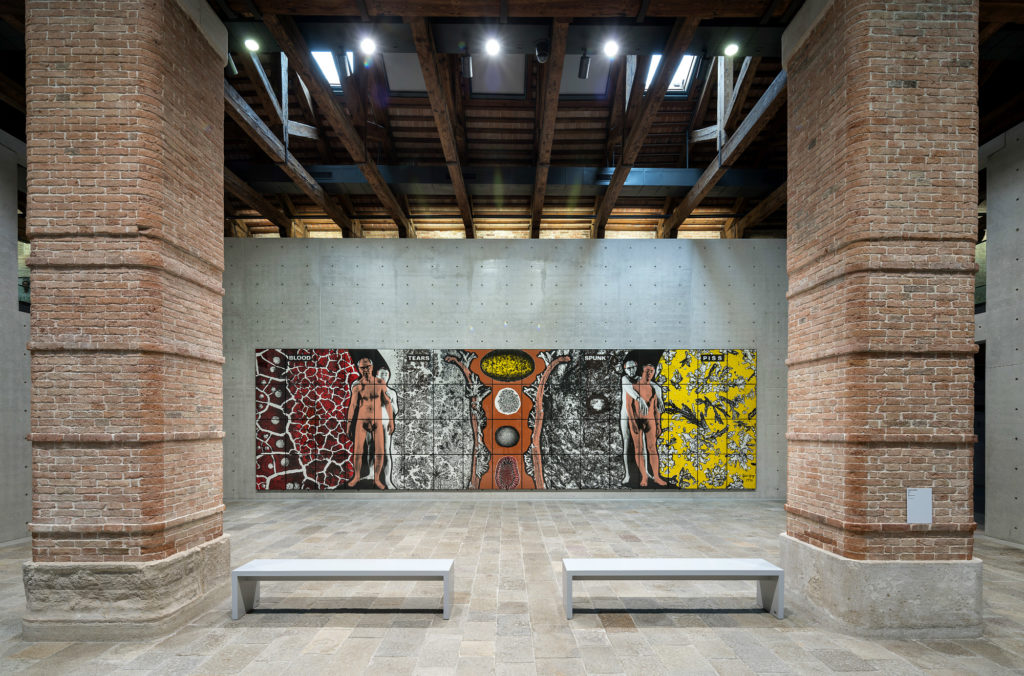
Gilbert & George, “Dancing with Myself,” installation view at Punta della Dogana, 2018, © Palazzo Grassi, photography by Matteo De Fina.
François Pinault turned to Venice 13 years ago after plans to open a Paris site in a former Renault factory on the Île Seguin were abandoned after a long series of hitches. Despite this, Bethenod insists that the longed-for achievement of a Paris space should be viewed as “an expansion.” That is, there are no plans to withdraw from Venice.
Asked how the Fondation Louis Vuitton planned to distinguish itself within an increasingly crowded field in Paris, its artistic director, Suzanne Pagé, said that the Gehry building—“the first work of art of the foundation”—would continue to be a draw in and of itself. She expounded the Foundation’s international vision (recent shows have been dedicated both to art from China and Africa), and their preference for showing “very contemporary art” in the context of modern works: “It’s essential to remember that art comes from art comes from art comes from art.”
More pointedly, Pagé noted: “First thing—we never sell works, never […] Here we are a museum: we have a public responsibility and we have responsibility to the artists. We buy, we never sell.”
As a recent long-format piece on the intermingling of François Pinault’s art and business interests in the French business weekly Challenges outlined, no such restrictions extend to the Pinault Collection, despite it often, and erroneously, being referred to as a foundation.
Exciting times lay ahead in Paris, and, one senses, not a little competitive spirit. One hopes the winner, ultimately, will be the city’s art-loving public.
“In Tune With the World” runs from April 11–August 27 at the Fondation Louis Vuitton, Paris.
“Dancing with Myself” runs from April 8–December 16 at the Punta della Dogana, Venice.
“Albert Oehlen: Cows by the Water” runs from April 8–January 6, 2019 at the Palazzo Grassi, Venice.